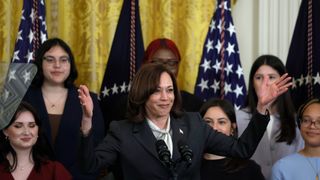“Those bragging about overturning Roe v Wade have no clue about the power of women in America.”
In what could be his last State of the Union address, Joe Biden, the 46th consecutive male president, made an appeal to the group that will make or break his success come November — women.
This won’t be the year in which Americans elect a female president who finally shatters the “highest, hardest glass ceiling”. However, women will still play a crucial role in determining the fate of the country in November.
Since 1980, women have turned out to vote at higher rates than men in every US presidential election. And with the 2020 race decided by just over 40,000 votes in three key states, this important demographic could make all the difference in critical swing states that will be won or lost by razor-thin margins.
The latest The New York Times-Siena poll shows Biden and Donald Trump practically neck-and-neck in their electoral appeal among women. With Biden placing abortion rights “front and centre” of his re-election bid and Trump toying with the idea of choosing a female running mate, how are both candidates vying for women’s votes in 2024?
Women have voted for the Democratic candidate at higher rates than men in every presidential election since 1980. In 2020, Biden was no exception, winning just over half of all female voters (55 per cent). But his strongest support came from Black women — the Democrats’ most reliable voting bloc — of whom an overwhelming 95 per cent voted for Biden, helping to carry him over the line in crucial swing states like Georgia, Michigan and Pennsylvania.
On the campaign trail in 2020, Biden made a point of selecting a woman as his running mate. And as a history-making vice president two decades his junior, Kamala Harris is often tapped to engage the groups that the president might otherwise struggle to reach. Nowhere has this been truer than in her role as the administration’s primary messenger on abortion rights — something that Biden’s camp sees as a winning issue in the 2024 election cycle.
Biden’s campaign is hosting reproductive freedom rallies in battleground states, spending big on abortion-focused campaign ads and talking up Trump’s role in the US Supreme Court’s overturning of the Roe v Wade decision and the risks of a future federal ban. In his State of the Union address, Biden reiterated his promise to the American people: “If Americans send me a Congress that supports the right to choose, I promise you, I will restore Roe v Wade as the law of the land again.”
The president is no doubt hoping to replicate wins from the 2022 midterms, in which abortion was credited as helping the Democrats stave off a red wave — ranking close second to the economy as a key voter concern and even overtaking it in Michigan and Pennsylvania, despite historic levels of inflation.
While most Americans support abortion access, this is especially true among women — who are more likely to say they would only vote for a candidate who shares their view. In the month after the Dobbs decision that struck down Roe v Wade, the number of women registering to vote in the 2022 midterms surged by 35 per cent — roughly four times the rate of men.
Timing could be on Biden’s side, with the US Supreme Court this summer set to review a Texas court ruling that banned mifepristone, the drug used in most abortions performed in the United States. The first major abortion rights case to hit the court since the overturning of Roe v Wade could place abortion rights back in the national spotlight just months before the general election — right where Biden wants it to be.
In 2016, Trump bragged that he had “won women”. But while it’s true that he collected a slim majority of white women’s votes, the 2016 presidential election reported the widest “gender gap” in modern electoral history — meaning men preferred Trump and women preferred Hillary Clinton by the greatest margin of any presidential match-up since 1972.
Trump closed in on this gap in 2020, growing his share of female voters from 39 per cent to 44 per cent. This year, he will be eager to build on these gains — and is reportedly considering choosing a woman as his vice-presidential running mate. If he does, she would be just the second Republican woman to be nominated for the vice presidency in US history, after John McCain’s 2008 run with Sarah Palin.
While a female running mate may not be a silver bullet, it could still aid Trump’s optics and help navigate campaign challenges such as the delicate issue of abortion policy in a post-Roe election.
Both candidates have their work cut out for them in appealing to this important demographic, but one thing is certain – while women may not be seen at the top of the ballot in 2024, their voices will be heard on 5 November.






